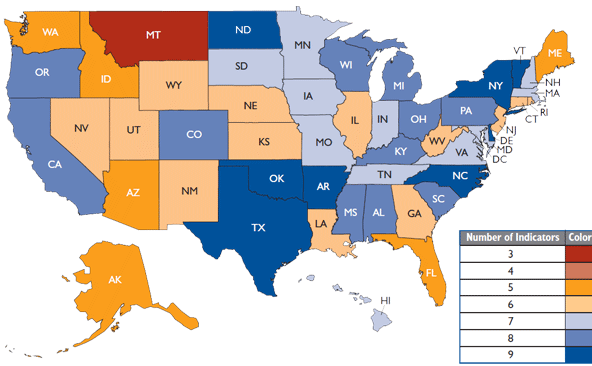Ready or Not? 2009
Protecting the Public's Health from Disease, Disasters, and Bioterrorism
The report finds that the H1N1 flu outbreak has exposed serious underlying gaps in the nation's ability to respond to public health emergencies and that the economic crisis is straining an already fragile public health system. It contains state-by-state health preparedness scores based on 10 key indicators.

Trust for America’s Health (TFAH) and the Robert Wood Johnson Foundation (RWJF) released the seventh annual Ready or Not? Protecting the Public’s Health from Diseases, Disasters, and Bioterrorism report, which finds that the H1N1 flu outbreak has exposed serious underlying gaps in the nation’s ability to respond to public health emergencies and that the economic crisis is straining an already fragile public health system.
The report contains state-by-state health preparedness scores based on 10 key indicators to assess health emergency preparedness capabilities. Twenty states scored six or less out of 10 key indicators of public health emergency preparedness. Nearly two-thirds of states scored seven or less. Eight states tied for the highest score of nine out of 10: Arkansas, Delaware, New York, North Carolina, North Dakota, Oklahoma, Texas, and Vermont. Montana had the lowest score at three out of 10. The preparedness indicators are developed in consultation with leading public health experts based on data from publicly available sources or information provided by public officials.
Overall, the report found that the investments made in pandemic and public health preparedness over the past several years dramatically improved U.S. readiness for the H1N1 outbreak. But it also found that decades of chronic underfunding meant that many core systems were not at-the-ready. Some key infrastructure concerns were a lack of real-time coordinated disease surveillance and laboratory testing, outdated vaccine production capabilities, limited hospital surge capacity, and a shrinking public health workforce. In addition, the report found that more than half of states experienced cuts to their public health funding and federal preparedness funds have been cut by 27 percent since fiscal year (FY) 2005, which puts improvements that have been made since the September 11, 2001 tragedies at risk.
Some key findings from the report include:
- 27 states cut funding for public health from FY 2007-08 to 2008-09.
- 13 states have purchased less than 50 percent of their share of federally subsidized antiviral drugs to stockpile for use during an influenza pandemic.
- 14 states do not have the capacity in place to assure the timely pick-up and delivery of laboratory samples on a 24/7 basis to the Laboratory Response Network (LRN).
- 11 states and D.C report not having enough laboratory staffing capacity to work five 12-hour days for six to eight weeks in response to an infectious disease outbreak, such as H1N1.
The report also offers a series of recommendations for improving preparedness, including:
- Ensure Stable and Sufficient Funding. The 27 percent cut to federal support for public health preparedness since FY 2005 must be restored, and funding must be stabilized at a sufficient level to support core activities and emergency planning. Increased funding must also be provided to modernize flu vaccine production, improve vaccine and antiviral research and development, and fully support the Hospital Preparedness Program.
- Conduct an H1N1 After-Action Report and Update Preparedness Plans with Lessons Learned. Strengths and weaknesses of the H1N1 response should be evaluated and used to revise and strengthen federal, state, and local preparedness planning, including assessing what additional resources are needed to be sufficiently prepared. Identified gaps in core systems, including communications, surveillance, and laboratories much be addressed. In addition, continued surge capacity concerns, including establishing crisis standards of care, must be addressed.
- Increase Accountability and Transparency. Federal and state health departments should regularly make updates on progress made on benchmarks and deliverables identified in the Pandemic and All Hazards Preparedness Act available to the public so they can see how tax dollars are being used and how well protected their communities are from health threats.
- Improve Community Preparedness. Additional measures must be taken to reach out quickly and effectively to high-risk populations, including strengthening culturally competent communications around the safety of vaccines. Health disparities among low-income and racial/ethnic minorities, who are often at higher risk during emergencies, must also be addressed.
